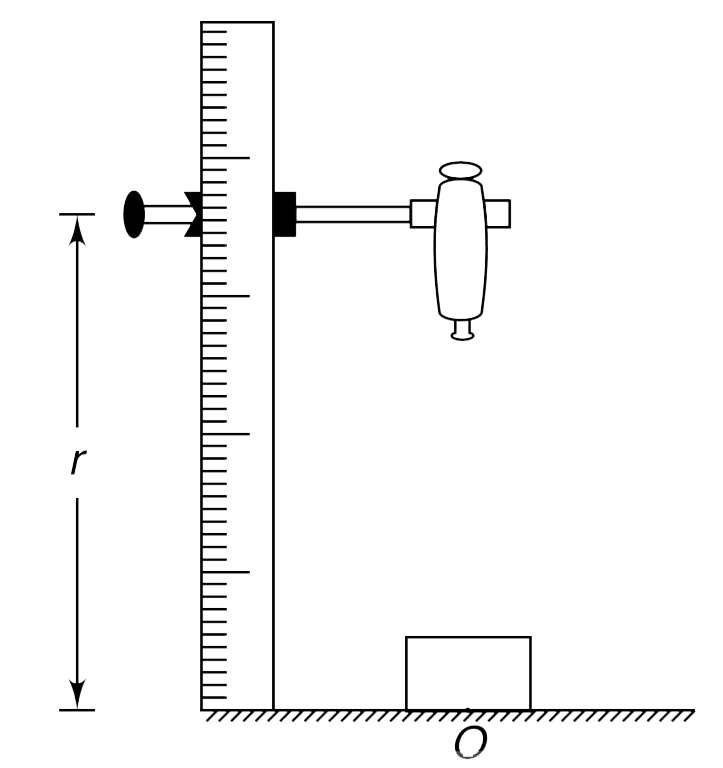A microscope is focused on a mark on a piece of paper and then a slab of glass of thickness 3cm and refractive index 1.5 is placed over the mark. How should the microscope be moved to get the mark in focus again ?
1cm upward
4.5cm downward
1cm downward
2cm upward
The correct Answer is:A
To solve the problem of how to adjust the microscope after placing a glass slab over the mark, we need to calculate the apparent depth of the mark when viewed through the glass slab. Here’s a step-by-step solution:
Step 1: Understand the situation
The microscope is initially focused on a mark on a piece of paper. When a glass slab of thickness t=3cm and refractive index μ=1.5 is placed over the mark, the apparent depth of the mark changes.
Step 2: Use the formula for apparent depth
The formula for apparent depth d′ when viewing through a medium is given by:
d′=dμ
where d is the actual depth (thickness of the slab) and μ is the refractive index of the slab.
Step 3: Substitute the values
Here, the actual depth d=3cm and the refractive index μ=1.5. Plugging in these values:
d′=3cm1.5=2cm
Step 4: Determine the change in position
Initially, the microscope was focused on the mark at an actual depth of 3cm. After placing the slab, the apparent depth is now 2cm.
Step 5: Calculate the distance to move the microscope
The microscope must be moved to focus on the new apparent depth. The difference in depth is:
Distance to move=Actual depth−Apparent depth=3cm−2cm=1cm
Step 6: Conclusion
To get the mark in focus again, the microscope should be moved 1 cm closer to the mark.
---
The microscope is initially focused on a mark on a piece of paper. When a glass slab of thickness t=3cm and refractive index μ=1.5 is placed over the mark, the apparent depth of the mark changes.
The formula for apparent depth d′ when viewing through a medium is given by:
d′=dμ
where d is the actual depth (thickness of the slab) and μ is the refractive index of the slab.
Here, the actual depth d=3cm and the refractive index μ=1.5. Plugging in these values:
d′=3cm1.5=2cm
Initially, the microscope was focused on the mark at an actual depth of 3cm. After placing the slab, the apparent depth is now 2cm.
The microscope must be moved to focus on the new apparent depth. The difference in depth is:
Distance to move=Actual depth−Apparent depth=3cm−2cm=1cm
To get the mark in focus again, the microscope should be moved 1 cm closer to the mark.
Topper's Solved these Questions
- GEOMETRICAL OPTICSBook:A2ZChapter:GEOMETRICAL OPTICSExercise:Assertion Reason
Explore 15 Videos
- GEOMETRICAL OPTICSBook:A2ZChapter:GEOMETRICAL OPTICSExercise:Section D - Chapter End Test
Explore 30 Videos
- GEOMETRICAL OPTICSBook:A2ZChapter:GEOMETRICAL OPTICSExercise:Section B - Assertion Reasoning
Explore 19 Videos
- ELECTROMAGNETIC WAVES AND COMMUNICATION SYSTEM Book:A2ZChapter:ELECTROMAGNETIC WAVES AND COMMUNICATION SYSTEM Exercise:Section D - Chapter End Test
Explore 30 Videos
- MAGNETISM AND MATTERBook:A2ZChapter:MAGNETISM AND MATTERExercise:Section D - Chapter End Test
Explore 30 Videos
Similar Questions
A travelling microscope can move vertically along a scale. It is focused at a mark O on the table and the reading on the vertical scale isr1. Now a glass slab is placed over mark O and the microscope has to be moved up to bring the mark in focus again. This time the scale reads r2. Lycopodium powder is spread over the top of the glass slab and the microscope is moved up once again to bring the powder particles in sharp focus. This time the vertical scale reads r3. Find the refractive index of the material of the glass slab.

View SolutionAn ink mark on a sheet of paper is viewed through a glass slab of thickness t and refractive index μ. Through what distance the mark appears to be raised ?
View Solution
Knowledge Check
The time taken by a ray of light to travel through a glass slab of thickness 2 cm and refractive index 1.5 will be
A10^(-8) sB10−10sC2×10−8sD10−12sA small ink dot on a paper is seen through s glass slab of thickness 4cm and refractive index 1.5. The dot appears to be raised by
A1cmB2cmC3cmD1.33cmA microscope is focussed on an ink mark on the top of a table. If we place a glass slab of 3 cm thick on it, how should the microscope be moved to focus the ink spot again? The refractive index of glass is 1.5
A2 cm upwardsB2 cm downwardsC1 cm upwardsD1 cm upwards
A travelling microscope is focussed on a mark made on a paper. When a slab of 1.45cm thickness is placed on the marl, the microscope has to be raised through 0.49 cm to focus the mark again. Calculate the refractive index of glass.
View SolutionA small ink dot on a paper is viewed through a glass slab of thickness 10cm , and refractive index 1.5. By what distance would the dot appear to be raised ?
View SolutionA small ink dot on a paper is viewed through a glass slab of thickness 10cm and refractive index 1.5. By what distance would the dot appear to be raised?
View SolutionCalculate the shift produced by the slab having thickness 15cm and refractive index 1.5 which is kept in air.
View SolutionA point object is placed in front of a concave mirror. And its image is found to coincide with its own position. Now a glass slab of thickness 15 cm and refractive index 1.5 is placed in between object and the mirror. In order to form image again at the location of object, it is required to move the object
View Solution